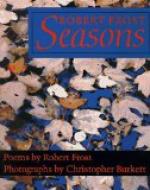|
This section contains 462 words (approx. 2 pages at 300 words per page) |

|
Robert Frost & the New Deal
Summary: Essay applies Robert Frost's famous poem, "Nothing Gold Can Stay" to the events that occured during the Great Depression and Franklin D. Roosevelt's New Deal.
October 24, 1929, often referred to as Black Thursday, marked the beginning of the great downward spiral of America's economy. In the famous poem, "Nothing Gold Can Stay" Robert Frost illustrates the fleeing of "golden" moments through the changing of the seasons. The 1920s in America were a roaring decade. After the end of World War I, people were determined to have an optimistic outlook on life and put the past behind them. Many people were living the wild night life filled with flappers, jazz, and alcohol. This exciting lifestyle came to an abrupt halt in 1929 when the stock market crash sent the country head first into the Great Depression. The symbolism in Robert Frost's poem can be very easily applied to the turmoil of the Great Depression and its aftermath. The prosperous 1920's can be though of as a "golden" time in America, which would inevitably end, just as...
|
This section contains 462 words (approx. 2 pages at 300 words per page) |

|


